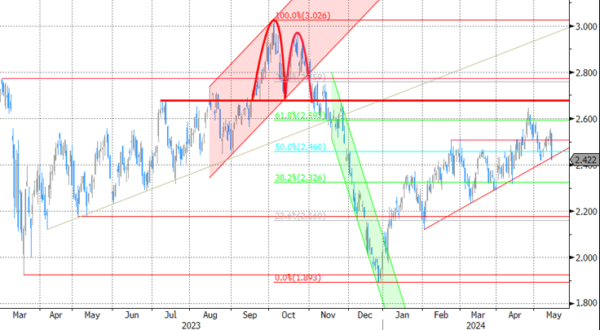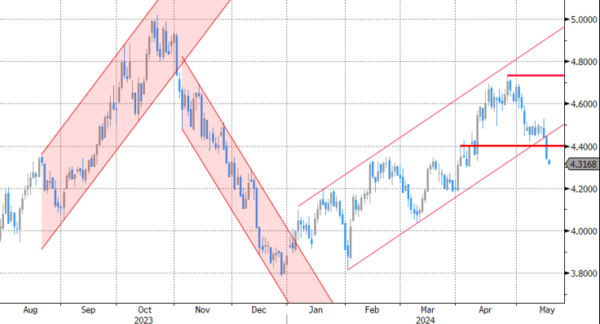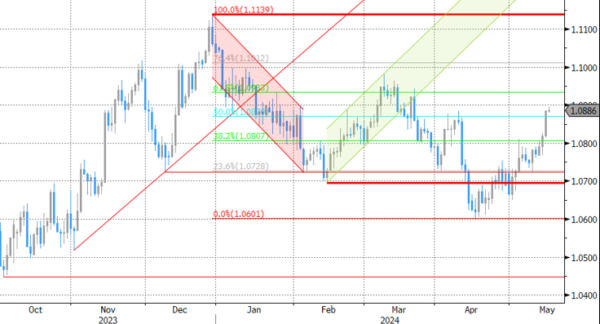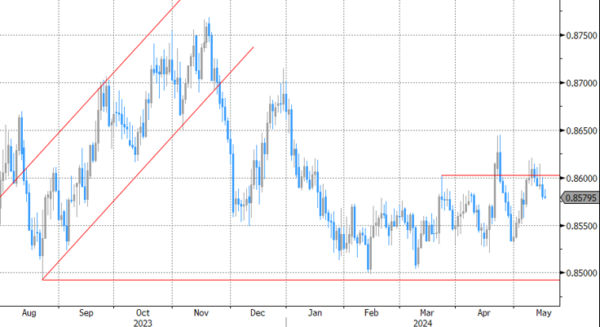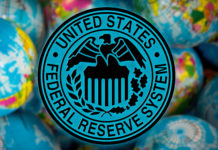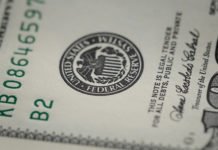Markets
US CPI inflation contrasted with the PPI shocker (+0.5% M/M) from Tuesday. Price pressures eased slightly in April (0.3% M/M for headline and core; down from 0.4% M/M for both in March) but the CPI report was in line with expectations. Flanked by disappointing US retail sales (flat M/M) and a weaker May Empire Manufacturing business survey (-15.6 from -14.3), it triggered an outsized relief rally on markets. US Treasuries were already well bid in the run up to the data and extended gains afterwards. US yields eventually dropped 8.6 bps (30-yr) to 10.9 bps (5-yr) across the curve. From a technical point of view, they fell back to or even below the levels from before the previous (March) inflation report which triggered the opposite market reaction. We consider these levels as first important support which should be able to hold into this week’s close. For the US 2-yr and 10-yr yield, these levels are respectively 4.7% and 4.35%. The loss of interest rate support put the dollar in the defensive with EUR/USD currently testing a similar reference at 1.0885. US stock markets cheered at the outcome, rallying 0.9% to 1.4% with new all-time highs for the Dow Jones, S&P 500 and Nasdaq. While we don’t expect yesterday’s data to alter current Fed thinking – on hold for longer -, they did influence US money markets. 25 bps rate cuts are now discounted for the September and December meetings with January (50%) coming into play for a third move. Today’s eco calendar is again well-filled in the US with weekly jobless claims, housing data (starts & permits), the Philly Fed business outlook, industrial production figures and import/export prices. Fed speakers include Goolsbee, Barkin, Harker, Mester and Bostic. We don’t expect them to bring a July rate cut back into play, suggesting a slowing in this week’s trends.
Yesterday’s US Treasury rally had global repercussions with European and UK bond yields facing more or less similar losses. An avalanche of ECB members hits the wires today as well, but they won’t alter their common message. A June rate cut is a done deal, but the central bank won’t pre-commit to a specific rate path in H2 2024. Next week’s Q1 wage data could already be a first complicating factor in embarking on a genuine cutting cycle.
News & Views
Japanese GDP growth contracted by 0.5% Q/Q (-2% Q/Qa) in Q1.The outcome was worse than expected. Making the picture even less compelling, Q4 2023 growth faced a downward revision from 0.4% Q/Qa to 0%. Private consumption declined for a fourth consecutive quarter (-0.7% Q/Q), illustrating the impact of negative real income growth on spending. Private investment fell by 0.8% Q/Q. Net exports also subtracted a net 0.3 ppts from growth as exports declined more than imports. Some of the factors weighing on growth (earthquake in January, lower production in the automobile sector) might have been temporary in nature, but still the picture looks unconvincing. The price deflator of the series slowed less than expected from 3.9% to 3.6%. Weak data don’t make it easier for the BoJ to continue policy normalization. However, in this process the focus will probably be on wage growth with persistent yen weakness also being in play. The Japanese currency this morning extends yesterday’s rebound, but this is mainly driven by USD-weakness in the wake of yesterday’s data.(USD/JPY 154).
After slightly softer than expected Q1 wage data published yesterday, Australian April jobs data this morning added to evidence that the labour market is cooling. Employment rose a bigger than expected 38.5k, but this didn’t suffice to cope with an even more pronounced rise in the labour force. This caused the unemployment rate to rise from 3.9% to 4.1%, matching the ST peak level from January. The combination of slower wage growth and a higher unemployment rate might give some comfort to the RBA as it still looks for more convincing signs that inflation is heading back to its 2-3% inflation target. Australian yields this morning declined further, reinforcing yesterday’s global trend (3-yr: -13 bps). After briefly trading above AUD/USD 0.67 this morning, the Aussie dollar reversed initial gains (currently 0.668). Still the picture turned more constructive after yesterday’s break above the 0.667 area.
Graphs
GE 10y yield
ECB President Lagarde clearly hinted at a summer (June) rate cut which has broad backing. EMU disinflation continued in April and brought headline CPI closer to the 2% target. Together with weak growth momentum, this gives backing to deliver a first 25 bps rate cut. A more bumpy inflation path in H2 2024 and the Fed’s higher for longer strategy make follow-up moves difficult. Markets have come to terms with that.
US 10y yield
The Fed in May acknowledged the lack of progress towards the 2% inflation objective, but Fed’s Powell left the door open for rate cuts later this year. Soft US ISM’s and weaker than expected payrolls supported markets’ hope on a first cut post summer, triggering a correction off YTD peak levels. Sticky inflation suggests any rate cut will be a tough balancing act. 4.37% (38% retracement Dec/April) already might prove strong support for the US 10-y yield.
EUR/USD
Economic divergence, a likely desynchronized rate cut cycle with the ECB exceptionally taking the lead and higher than expected US CPI data pushed EUR/USD to the 1.06 area. From there, better EMU data gave the euro some breathing space. The dollar lost further momentum on softer than expected early May US data. Some further consolidation in the 1.07/1.09 are might be on the cards short-term.
EUR/GBP
Debate at the Bank of England is focused at the timing of rate cuts. Most BoE members align with the ECB rather than with Fed view, suggesting that the disinflation process provides a window of opportunity to make policy less restrictive (in the near term). Sterling’s downside turned more vulnerable with the topside of the sideways EUR/GBP 0.8493 – 0.8768 trading range serving as the first real technical reference.




